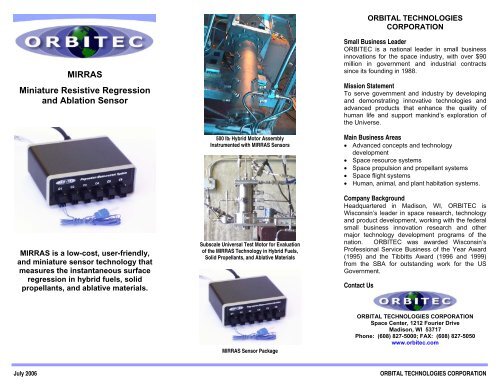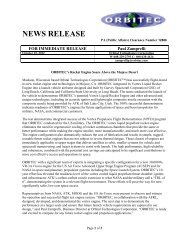MIRRAS Miniature Resistive Regression and Ablation Sensor
MIRRAS Miniature Resistive Regression and Ablation Sensor
MIRRAS Miniature Resistive Regression and Ablation Sensor
You also want an ePaper? Increase the reach of your titles
YUMPU automatically turns print PDFs into web optimized ePapers that Google loves.
ORBITAL TECHNOLOGIES<br />
CORPORATION<br />
<strong>MIRRAS</strong><br />
<strong>Miniature</strong> <strong>Resistive</strong> <strong>Regression</strong><br />
<strong>and</strong> <strong>Ablation</strong> <strong>Sensor</strong><br />
Small Business Leader<br />
ORBITEC is a national leader in small business<br />
innovations for the space industry, with over $90<br />
million in government <strong>and</strong> industrial contracts<br />
since its founding in 1988.<br />
Mission Statement<br />
To serve government <strong>and</strong> industry by developing<br />
<strong>and</strong> demonstrating innovative technologies <strong>and</strong><br />
advanced products that enhance the quality of<br />
human life <strong>and</strong> support mankind’s exploration of<br />
the Universe.<br />
<strong>MIRRAS</strong> is a low-cost, user-friendly,<br />
<strong>and</strong> miniature sensor technology that<br />
measures the instantaneous surface<br />
regression in hybrid fuels, solid<br />
propellants, <strong>and</strong> ablative materials.<br />
500 lbf Hybrid Motor Assembly<br />
Instrumented with <strong>MIRRAS</strong> <strong>Sensor</strong>s<br />
Subscale Universal Test Motor for Evaluation<br />
of the <strong>MIRRAS</strong> Technology in Hybrid Fuels,<br />
Solid Propellants, <strong>and</strong> Ablative Materials<br />
Main Business Areas<br />
• Advanced concepts <strong>and</strong> technology<br />
development<br />
• Space resource systems<br />
• Space propulsion <strong>and</strong> propellant systems<br />
• Space flight systems<br />
• Human, animal, <strong>and</strong> plant habitation systems.<br />
Company Background<br />
Headquartered in Madison, WI, ORBITEC is<br />
Wisconsin’s leader in space research, technology<br />
<strong>and</strong> product development, working with the federal<br />
small business innovation research <strong>and</strong> other<br />
major technology development programs of the<br />
nation. ORBITEC was awarded Wisconsin’s<br />
Professional Service Business of the Year Award<br />
(1995) <strong>and</strong> the Tibbitts Award (1996 <strong>and</strong> 1999)<br />
from the SBA for outst<strong>and</strong>ing work for the US<br />
Government.<br />
Contact Us<br />
<strong>MIRRAS</strong> <strong>Sensor</strong> Package<br />
ORBITAL TECHNOLOGIES CORPORATION<br />
Space Center, 1212 Fourier Drive<br />
Madison, WI 53717<br />
Phone: (608) 827-5000; FAX: (608) 827-5050<br />
www.orbitec.com<br />
July 2006 ORBITAL TECHNOLOGIES CORPORATION
<strong>Miniature</strong> <strong>Resistive</strong> <strong>Regression</strong> <strong>and</strong> <strong>Ablation</strong><br />
<strong>Sensor</strong> (<strong>MIRRAS</strong>)<br />
Advancements are continuously being sought in<br />
hybrid fuels <strong>and</strong> oxidizers, solid propellants, <strong>and</strong><br />
ablative materials. The surface regression<br />
characteristics of these materials need to be<br />
determined as a function of key operational<br />
parameters to establish their overall<br />
performance <strong>and</strong> merit <strong>and</strong> to support overall<br />
system design. A similar need exists for<br />
propellant <strong>and</strong> material health monitoring.<br />
ORBITEC has addressed these needs through<br />
the development of a sensor that can accurately<br />
measure instantaneous surface regression at a<br />
fraction of the cost, size, <strong>and</strong> complexity of other<br />
currently available methods. The resulting<br />
instrument is called the <strong>Miniature</strong> <strong>Resistive</strong><br />
<strong>Regression</strong> <strong>and</strong> <strong>Ablation</strong> <strong>Sensor</strong> (<strong>MIRRAS</strong>).<br />
This work was sponsored by the NASA/SSC<br />
SBIR Program.<br />
<strong>MIRRAS</strong> Capabilities/Features<br />
• Provides highly accurate, instantaneous<br />
surface regression <strong>and</strong> material thickness data<br />
•<br />
•<br />
•<br />
•<br />
•<br />
•<br />
•<br />
Applied <strong>and</strong> tested in hybrid fuels, solid<br />
propellants, <strong>and</strong> ablative materials<br />
Eliminates the need for specialized end user<br />
training or calibration<br />
Reduces implementation cost as compared<br />
to ultrasonic, X-ray, <strong>and</strong> optical methods<br />
Improves regression data quality <strong>and</strong> reliability<br />
by measuring transients that often go undetected<br />
Increases safety of operations<br />
Reduces the number of required<br />
developmental tests<br />
Well suited for flight applications because of<br />
small size <strong>and</strong> low mass.<br />
<strong>MIRRAS</strong> Applications<br />
• Materials <strong>and</strong> propellant regression rate<br />
characterization<br />
• Propulsion system design <strong>and</strong> development<br />
• Health monitoring.<br />
How Does <strong>MIRRAS</strong> Work?<br />
The <strong>MIRRAS</strong> sensor is designed to be<br />
embedded in the material of interest <strong>and</strong><br />
regresses along with it. During this process, the<br />
resistance of the sensor is related to its<br />
instantaneous length, allowing the instantaneous<br />
thickness of the host material to be recorded.<br />
The time derivative of these data reveals the<br />
instantaneous surface regression rate as a<br />
function of time.<br />
<strong>Sensor</strong> Installation: Two sensor installation<br />
approaches have been successfully developed.<br />
The first is to directly cast sensors into the host<br />
material. The second is to insert them after the<br />
material has been formed or cured. Accurate<br />
sensor positioning within the host material is<br />
straightforward for most applications.<br />
<strong>Sensor</strong> Design <strong>and</strong> Operation: <strong>MIRRAS</strong> is a<br />
specialized resistor that has been designed to<br />
meet the following requirements: (1) regresses<br />
at the same rate as the host material; (2) does<br />
not affect the regression of the host material or<br />
adversely disrupt the process under study; (3)<br />
exhibits a resistance that can be accurately<br />
correlated to the instantaneous sensor length;<br />
(4) does not require any end user calibration or<br />
training; (5) is easy to install <strong>and</strong> operate; <strong>and</strong><br />
(6) is low cost.<br />
Signal Conditioning: A multi-channel channel<br />
signal conditioner has been developed. It<br />
accommodates up to six sensors over a wide<br />
range of sensor sizes <strong>and</strong> provides a voltage<br />
signal related to the instantaneous sensor<br />
length.<br />
Data Transmission: The sensor signal is<br />
transmitted from inside a high-pressure chamber<br />
to the ambient environment on two leadwires<br />
through a port in the side or top of the motor<br />
case. St<strong>and</strong>ard commercially available<br />
feedthrough connectors produce a seal around<br />
the wires. Another approach is to use a<br />
miniature signal conditioner <strong>and</strong> data logger<br />
installed inside the chamber, possibly embedded<br />
in the motor case lining. The data logger would<br />
record data during the test <strong>and</strong> could later be<br />
retrieved for downloading. Alternatively, a<br />
miniature transmitter could be used to send<br />
sensor data to an external receiver in real time.<br />
These two approaches eliminate the need to<br />
produce any motor case penetrations <strong>and</strong> are<br />
particularly well suited for flight-type motor<br />
testing or onboard flight systems.<br />
<strong>Sensor</strong> Output: The sensor provides localized<br />
instantaneous material thickness <strong>and</strong> surface<br />
regression rate data as a function of time.<br />
<strong>Regression</strong> Rate (cm/s)<br />
Ablative Thickness (cm)<br />
0.14<br />
0.13<br />
0.12<br />
0.11<br />
0.1<br />
0.09<br />
0.08<br />
0.07<br />
2<br />
1.8<br />
1.6<br />
1.4<br />
1.2<br />
1<br />
0.8<br />
0 5 10 15 20<br />
Time (s)<br />
<strong>Regression</strong> Rate vs. Time Measured<br />
Using <strong>MIRRAS</strong> Technology in an<br />
HTPB/GOX Hybrid Motor<br />
Location #1<br />
0.6<br />
0 4 8 12 16<br />
Time (s)<br />
Location #2<br />
<strong>MIRRAS</strong> Can Measure Local Material<br />
Thickness as a Function of Time




